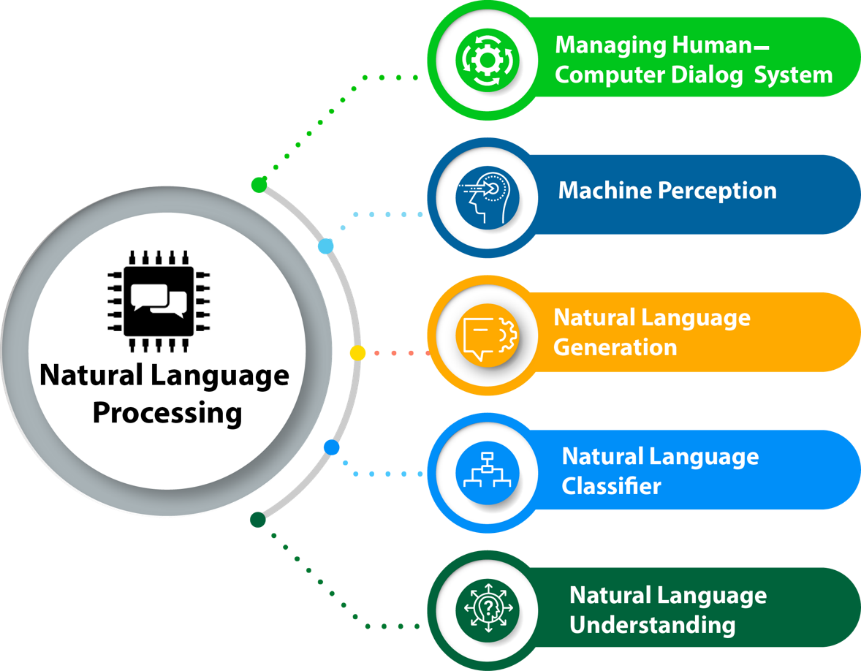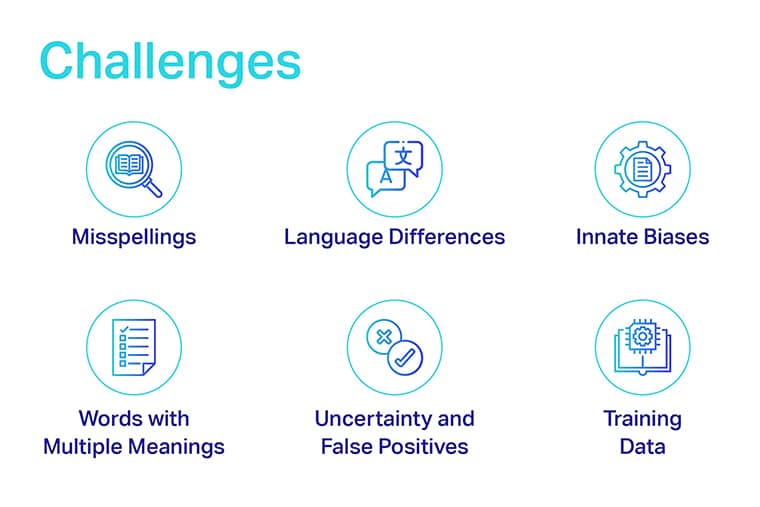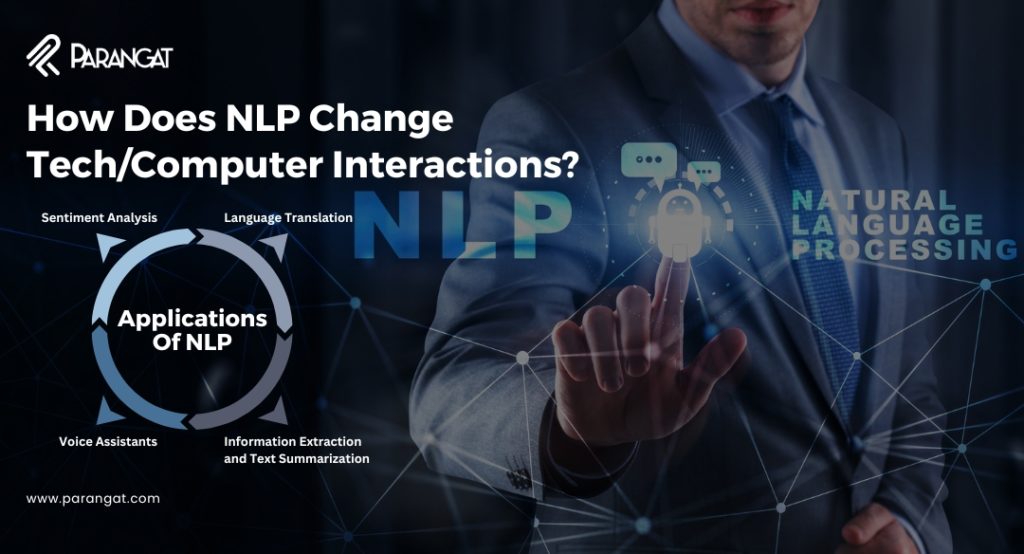In the digital era of AI, Natural language processing (NLP) is one of the primary fields that has experienced substantial growth. Computers can now understand, analyze, and produce human language with natural language processing (NLP). It includes various real-world applications in several fields, such as search engines, business intelligence, medicine, and many more.
Read the blog to learn how NLP can change tech/computer interactions.
What Is NLP?
NLP, a branch of artificial intelligence, aims to close the communication gap between humans and machines. It entails the creation of algorithms and methods that enable computers to process, analyze, and produce human language meaningfully. NLP has emerged as a critical element in many applications and technologies that rely on language interactions in the Age of AI.
Explore How AI Transform The Future Of Graphic Design?
How Does Natural Language Processing Work?
Computers can now understand natural language just like people do with the help of NLP. Natural language processing uses the advanced technology of artificial intelligence to take real-world input, process it, and enable computers to comprehend, regardless of whether the language is spoken or written. Computers have reading programs and microphones to collect audio, much as humans have various sensors like ears to hear and eyes to see. Computers have a program to process their different inputs, just as humans have a brain. The information is eventually translated into computer-readable code during processing.
Creating algorithms and data preprocessing are the two fundamental stages of natural language processing. Preparing and cleaning text data so computers can analyze it is known as data preparation. Preprocessing organizes data for use, highlighting text features an algorithm can use. You can do this in several ways, including:
- Tokenization: Text gets divided into smaller units at this point.
- Stop removing words: Common words are eliminated, leaving only the particular comments that show the most about the text.
- Stemming and Lemmatization: At this point, words get reduced to their root form for processing.
- Speech-act Tagging: Finally, words are labeled based on the part of speech they are, such as nouns, verbs, and adjectives.
Also read The Presence And Menace Of AI In Our Everyday Lives
Applications Of NLP In The Age Of AI
NLP has changed our lives beautifully and revolutionized how we communicate with technology. Let’s know some of the most essential NLP-based applications:
1. Sentiment Analysis:
Understanding human emotions and views is crucial in the modern world where AI and human intelligence intersect. NLP-based sentiment analysis allows machines to comprehend and assess the sentiments underlying spoken or written words, showcasing the capacity of AI to interpret emotions. This analysis enables businesses to glean insights into public opinion, social media sentiment, and customer feedback, highlighting the synergy between AI and human intelligence in understanding and analyzing complex emotional nuances.
2. Language Translation:
In the age of AI, NLP has made significant progress in removing language barriers. Machine translation algorithms use NLP approaches to translate text or speech from one language to another. This promotes cross-cultural understanding and facilitates worldwide communication.
4. Voice Assistants:
Natural language processing (NLP) allows voice assistants like Siri, Alexa, and Google Assistant to recognize and carry out voice requests. These assistants offer hands-free access to information, entertainment, and smart home control by utilizing NLP algorithms for speech recognition and natural language interpretation.
5. Information Extraction and Text Summarization:
As digital information increases, NLP approaches HELP in extracting insightful information from unstructured data. Algorithms for information extraction examine text documents to find entities, connections, and essential details. Long documents can be condensed into summaries using text summarising algorithms, allowing for adequate information consumption.
Must read: Leveraging Open-Source Tools: Exploring AI Trends And Coding Tutorials
Why Does NLP Matter To Cogwise?
NLP is crucial for Cogwise’s operation as it allows the chatbot to understand and analyze human language inputs. They can respond to the user’s query excitingly and relevantly. For instance, the chatbot can interpret the user’s inputs using NLP, producing useful but frequently ludicrous responses. Cogwise uses NLP algorithms to understand better the context and meaning of the user’s information so that it can respond in a valuable and topical way.
How Does The Global Market Utilize The Benefits Of NLP?
- Extracting Insights From Unstructured Data: The capacity of NLP to extract insightful information from unstructured text input is one of its primary advantages. For instance, in the healthcare sector, NLP algorithms identify medical records to find trends, extract patient data, and support diagnosis and treatment planning. This promotes the overall delivery of healthcare by streamlining procedures and improving patient outcomes.

- Breaking Language Barriers: With the arrival of NLP, language translation has made great strides. NLP algorithms are used by services like Google Translate to process and translate text between multiple languages, promoting cross-cultural dialogue and cross-border commerce. NLP-powered translation technology has significantly lowered language barriers, whether for international travel, collaboration, or ordinary communication.
- Understanding Customer Feedback And Sentiment: Thanks to sentiment analysis made possible by NLP, organizations can now precisely measure public opinion and consumer happiness, exemplifying the transformative role of AI in customer service. Companies may obtain priceless insights into sentiment trends, pinpoint areas for improvement, and make data-driven decisions to enhance their goods and services by examining social media posts, customer reviews, and feedback. For instance, an online retailer can quickly identify and resolve the main problems customers frequently note in their studies, demonstrating the integration of AI in improving customer service and satisfaction.
- Efficient Text Summarization: NLP provides a helpful remedy for the age of information overload by automating text summaries. Professionals in industries including media, law, and research can quickly extract meaningful information from lengthy papers. NLP-based summarising tools allow users to concentrate on essential insights while saving time and increasing productivity. For instance, journalists can swiftly summarise news stories to ensure they are current on current affairs.
- Unlocking Automated Content Generation: The capacity of NLP, exemplified by ChatGPT, to produce text that sounds like human speech opens the door to automated content production and personalized messaging. Businesses can use NLP, like ChatGPT, to create chatbot responses, email campaigns, and product descriptions. This technology, in the form of ChatGPT, helps content marketers and enterprises by speeding up content creation, fostering creativity, and allowing personalized consumer communication.
- Enhancing Information Extraction: Named entities (names, locations, organizations, and dates) are among the specific information from text that NLP is particularly good at extracting. Applications for this technology can be found in many fields, such as social media monitoring, news analysis, and legal research. For example, it can assist in tracking trends about certain themes or identify mentions of specific companies, allowing businesses to stay informed and make deft judgments.
- Voice Assistants: Voice-activated virtual assistants like Siri, Alexa, and Google Assistant have increased thanks to NLP. These assistants provide a smooth user experience using NLP skills to comprehend spoken requests and respond accordingly. They can play music, update the weather, make reminders, and respond to general knowledge quizzes. NLP gives Voice assistants additional power, making technology more approachable and user-friendly.
- Empowering Conversational AI: Virtual assistants and chatbots are now essential corporate tools. These conversational AI systems’ primary building block is NLP, which enables them to recognize and intuitively react to user inquiries. The scheduling of appointments, customer service, and information retrieval have all been transformed by this technology. For instance, chatbots on e-commerce websites assist users in finding products, responding to inquiries, and offering tailored recommendations, improving the whole buying experience.
Read About Edge AI: A Comprehensive Guide To Features And Challenges
Challenges In NLP
Although NLP has advanced significantly in the Age of AI, it still has several issues that academics and developers are trying to solve. These difficulties include:

- Ambiguity And Context Understanding: Human language is fundamentally complicated, frequently ambiguous, and highly dependent on context. To achieve high-level language understanding, NLP systems find it challenging to correctly analyze nuances, figurative language, and context-dependent meanings.
- Multilingual And Cross-Cultural Challenges: The rich range of languages and cultural subtleties present NLP approaches with several adaptation challenges. Obstacles to creating efficient NLP solutions include translating idiomatic idioms, maintaining cultural context, and addressing language-specific issues.
- Handling Slang, Jargon, And Colloquial Language: Slang, jargon, and colloquial language are frequently used in daily conversation. For NLP systems to accurately interpret and provide human-like replies, they must be trained to comprehend and process these changes.
- Dealing With Large-Scale Data And Computational Requirements: NLP frequently necessitates processing Large-Scale Textual Data, which can be computationally demanding. Efficient algorithms and scalable infrastructure are crucial to handle the increasing data volumes and provide real-time results.
Future Trends In NLP
Exciting possibilities lie ahead for the future of AI in the AI Age. The following new trends are influencing the direction of NLP
- Advances In Deep Learning And Neural Networks: Deep learning and neural network advancements have considerably improved NLP capabilities. Examples include transformer models and recurrent neural networks. More complex language understanding and generation will be possible with further developments in neural architectures and training techniques.
- Personalized NLP Solutions For People And Industries: NLP systems will be more customized to individual users and industry-specific requirements. Customized and domain-specific language models will produce more precise and contextually appropriate outcomes.
- Improved Language Understanding And Context Awareness: Future NLP models will work to grasp language more contextually and nuancedly, improving their capacity to decipher nuances in purpose, sentiment, and meaning.
- Ethical And Responsible Use Of NLP In AI Systems: As NLP spreads, ensuring ethical use and minimizing bias will be essential. Promoting fairness, accountability, and openness in NLP algorithms and their applications will pick up steam.
- Integration Of NLP With Other AI Technologies: Using NLP in conjunction with speech recognition, computer vision, and other AI fields will result in a multimodal understanding that is more thorough. More interactive and immersive AI experiences will be made possible by this integration
NLP Use Cases
Let’s explore how various sectors use natural language processing while considering the benefits.
- Consumer Services: Companies have used natural language processing to power virtual assistants, even though customer service situations are where NLP-powered chatbots and callbots are most frequently used. These helpers are conversational AI that can engage in more complex conversations. Additionally, NLP can connect a consumer with the proper personnel if it cannot address a problem.
- Human Resources: Natural language processing allows recruiters and HR staff to look through hundreds of resumes and identify promising applicants based on keywords, education, talents, and other factors. The data analysis capabilities of NLP are also perfect for examining employee surveys and swiftly identifying how employees feel about the workplace.
- Education: NLP-powered apps can identify improper or unnecessary grammar, check for spelling issues, and suggest more accessible ways to structure phrases. Text can also be translated into other languages using natural language processing, which can help pupils learn a second language.
- Healthcare: AI in healthcare has the potential to significantly enhance medical workflows. Through natural language processing, healthcare practitioners can leverage AI-powered apps to verbally communicate their actions and notes during procedures. The AI software then accurately transcribes these verbal inputs, streamlining documentation and reducing manual data entry. This integration of AI technology optimizes efficiency and accuracy in healthcare practices
- Finance: In finance, NLP and machine learning help create financial reports from invoices, statements, and other documents. By examining news articles, social media posts, and other internet sources for market attitudes, financial analysts can also use natural language processing to forecast stock market trends.
- Insurance: Natural language processing can analyze organized and unstructured data, allowing insurance companies to evaluate claims. Additionally, NLP may be trained to recognize odd information, enabling teams to detect false claims.
Must read: What Is AI Marketing & How Is It To Be Used?
Endnote About NLP
Human-computer interaction is being transformed by natural language processing (NLP). Its capacity to comprehend, translate, and produce human language opens up various applications in various fields. By allowing conversational AI, removing language barriers, and extracting insights from unstructured data, NLP helps businesses increase productivity, improve customer experiences, and make data-driven decisions. We may anticipate new developments from leaders like Parangat Technologies as we continue to investigate NLP’s possibilities, which will help to determine the direction of technology and make it easier to use, more accessible, and more seamlessly interwoven into our daily lives.

With roll up sleeves, dive in and get the job done approach, it was in the year 2010 when Sahil started Parangat Technologies. Emphasizing a healthy work culture and technology-driven company, he has successfully created a workplace where people love to work and live. He is a software engineer and a passionate blockchain enthusiast.


 +44-7511-112566
+44-7511-112566 +353-1-8079571
+353-1-8079571 +1-415-799-9792
+1-415-799-9792

